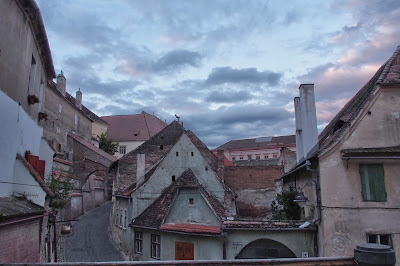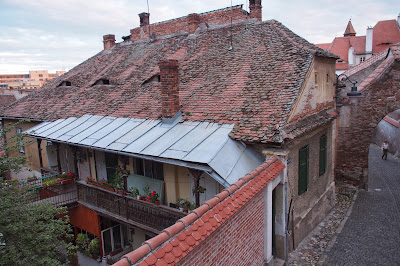After Brasov, we had to be on our way again to another part of Translyvania.
We passed through more river valleys
The weather was quite unstable. Sometimes we got the sun and sometimes we got rain
Our first rainbow in Balkans
We passed through a river
And a bridge
As the water was slow, there were algae everywhere
a river we passed
There was another rainbow
This one is much better formed
We even had a double rainbow!
Another bridge we passed
It was still raining
The sky had cleared somewhat
A village we passed
There were some mudflats
the clouds had cleared somewhat
But there were soon new clouds
The sun was setting
we passed through another plain
We've arrived at Sibiu. This is the Piata Mare, first mentioned in 1411 as a grain market, the Great
Square – the largest square in the city of Sibiu, called in ancient Romanian Sibiiu and Hermannstadt in German and
Nagyszeben in Hungarian, a city in Transylvania, with slightly less than
150,000 people situated 134 miles NW of Bucharest, straddling the Cibin
River (a tributary of the river Olt) and capital of Sibiu
County, between 1692 and 1791 and 1849-1865 and the capital of the
Principality of Transylvania and a quiet witness to the town’s lively commercial activities through the centuries,
its assemblies and even public executions. Located in the heart of the old
walled city, the square was designated an architectural monument by
UNESCO and features some of the most impressive buildings in Sibiu. It
was designated a European Capital of Culture for the year 2007.
Formerly the centre of the Transylvanian Saxons, the old city of Sibiu
was ranked as "Europe's 8th most idyllic place to live" by Forbes.
The town is divided into an upper and a lower part. For hundreds of years, this walled town in the heart of Transylvania was one of the most powerful and prosperous strongholds in Europe. Surrounded by imposing walls, Sibiu’s original fortifications included 39 defensive towers, five bulwarks, four gates and five artillery batteries. Although the entire network is remarkably well-preserved, the best-maintained section is the southeastern side which has been reinforced several times throughout the centuries since attacks most often came from that direction. Three 15th century towers have withstood the test of time: Harquebusiers’ Tower (Turnul Archebuzierilor), Carpenters’ Tower (Turnul Dulgherilor) and Potters’ Tower (Turnul Olarilor). The 16-th century Great Tower (Turnul Gros) was the site of Sibiu’s first theatrical performance, staged in 1778. At the centre of the upper town are three beautiful squares. The Great Square is the site of the Roman-Catholic church and the Brukenthal Palace, where you will find one of Romania's most important art collections. The square is linked to the Little Square by a passage beneath the Council Tower, which is worth visiting for the excellent views over the town. The third square, Huet Square, is dominated by the Evangelical Cathedral.
The town is divided into an upper and a lower part. For hundreds of years, this walled town in the heart of Transylvania was one of the most powerful and prosperous strongholds in Europe. Surrounded by imposing walls, Sibiu’s original fortifications included 39 defensive towers, five bulwarks, four gates and five artillery batteries. Although the entire network is remarkably well-preserved, the best-maintained section is the southeastern side which has been reinforced several times throughout the centuries since attacks most often came from that direction. Three 15th century towers have withstood the test of time: Harquebusiers’ Tower (Turnul Archebuzierilor), Carpenters’ Tower (Turnul Dulgherilor) and Potters’ Tower (Turnul Olarilor). The 16-th century Great Tower (Turnul Gros) was the site of Sibiu’s first theatrical performance, staged in 1778. At the centre of the upper town are three beautiful squares. The Great Square is the site of the Roman-Catholic church and the Brukenthal Palace, where you will find one of Romania's most important art collections. The square is linked to the Little Square by a passage beneath the Council Tower, which is worth visiting for the excellent views over the town. The third square, Huet Square, is dominated by the Evangelical Cathedral.
But first, we had to have dinner
our dining room
it had mirror on its roof
And grilles separating the room into two
Two musicians: a keyboardist and a singer who sang with feelings. I bought their CD
Our waitress
Some of our tour group members were dancing
Early the next morning, I got out to look around
This is a really old town. There are churches everywhere
The streets were quiet
The shape of some of the houses are very peculiar . This is the Borel House built and added to between the 14th to 18th centuries.
There are some open air restaurants by the side of that famous bridge of the upper town underneath which is the road leading to the lower town.
This is the oldest bridge in the city
Some Medieval arches
The road under the bridge leading from the new to the old town
There were flowers out side some of the houses in the old town quarters
This is the entrance to the old town

This is a restaurant but used to be a stop for horsesmen
this post with hooks was intended for horses' reins.
Some houses have steps outside
this post with hooks was intended for horses' reins.
Some houses have steps outside
The way down the old town
The sun was rising
The road follows the slant of the hills
Red of dawn over the old town
A path leading back to the town square
This is another historic building with some sections going back to the 15th, some 17th and some 18th centuries
A cobble-stone flower bed and old fashioned cast iron stands at the side
This is another historic building: the oldest part going back to the 15th century and the latest 18th century
The winding roads are full of arches
Many of such houses are still inhabited
They follow the contour of the land
Another narrow street in the upper town
This is a Reformed Church built in the 18th century
From time to time there are such long and narrow passages between houses
This is the Cariatides House from the 18th century with a very old fashioned wooden door.
This is the Ernst Weisenfeld boarding school, one of the oldest in the country
Another very old building with paints peeling off
The is the Orthodox Cathedral of Holy Trinity built in early 20th century by Szalay Ferencz
A detail of its door
its interior bathed in colors of various shades of gold
Another view
its altar

The eye-shaped windows are typical of the houses here: anything to do with the "evil eye" sold as a charm against evil in Turkey?
Back into a corner of the town square
Another old street
Two identical houses at the corner of the town square
An inner court of one of the houses
This is the new town library
Flowers outside the flower bed of the library
This is old Bibliotheca Astra(Star Library)
A chess board at a public park. Who left the roses there?
This is the Lutheran Church
The Building of the the Public Health Service
More old buildings, all painted yellow
The sun had come out for our breakfast
A public park close to our hotel
The is an office of the political party
Back to the town square
The office of democratic liberal party
Graffiti on a public phone booth
The windows had white porches painted above them
One of the inner courts
The entrance to the inner court
A bakery
This is how the chef transport the bagels from the over to the shelf
A popular type of bread which I saw many worker eating on the streets
Pastry
Pies
another patisserie
American influence
An icecream parlor
A salon
Another bakery
a book shop
Some of the books on display
More books on display
A really old building
its entrance
An orthodox priest

We are preparing to leave the city

































































































沒有留言:
張貼留言